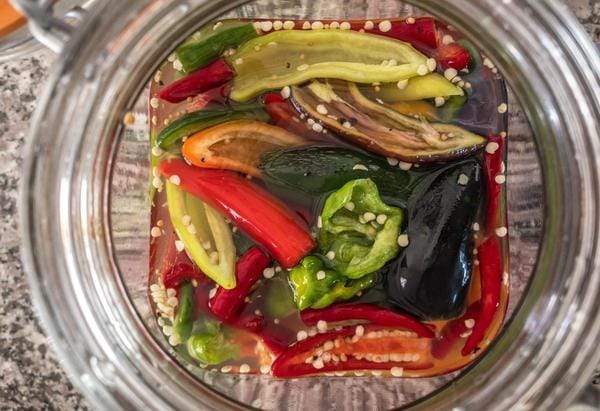This year our Trial Gardens and Germination Manager, Jaci, grew out our Pinetree Hot Pepper Mix to get a new photo of it. After we photographed it, we needed to make use of all the lovely peppers. So, what do you do with a basket full of hot peppers? Well, I make hot sauce because I love hot sauce.
Before my wife and I took over this seed company, I was a chef. So even though I love cooking and making things (#makersgonnamake), recipes are not my favorite. I love techniques and that's what I am giving you here, my fermented hot sauce method and/or technique. It’s not a recipe but it is the basic instructions for creating a fermented hot sauce with room to add your own spin on it.
This is a brine fermentation. You basically create a brine and submerge the hot peppers and wait. I love this method because not only does it produce a pretty awesome hot sauce, you also get a really flavorful spicy brine to use in other dishes. I like my hot sauce to be smooth, spicy, and acidic (like me😏). The base for this hot sauce can be as smooth as you want to make it but it won’t be that acidic, so I add a little splash of vinegar at the end when I puree. You certainly don’t have to do this and probably some would say it defeats the purpose of fermenting the hot sauce. Maybe I am compromising my culinary integrity, but vinegar is amazing and I love the addition!

What you need:
Hot peppers - Use whatever you have and as many as you have!
2% Brine - 20 grams of salt to 1 litre of water (I use Kosher). I weigh everything and you should too. If you don’t have a scale, you can add 1 Tbsp salt to 1 quart of water and get the correct ratio.
Anything else you want to add to the ferment - Collect any flavors you like and add them into the brine. I throw in a bunch of mustard seeds, some garlic cloves, some black peppercorns, and maybe a bay leaf or two. You can wrap your seasonings in cheesecloth to make it easier to remove later.
A jar - This should be a container meant for canning and fermenting (it is best to avoid metal containers as it can be reactive to the acid in the fermentation process). The fermentation process creates gas which creates pressure in the jar. You’ll be relieving that pressure regularly but you need a container that can handle it. Basic Ball jars work great and you can use one size jar to fit the whole batch or spread it out over several jars.
Gloves - Latex, vinyl, neoprene
What to do:
- Make your brine. Measure out the amount of water you’re using and add the appropriate amount of salt and any other spices that you’re using. Some people like to heat this up to dissolve the salt. If you heat it, you have to wait for it to cool before you add it to the peppers. I choose not to heat it and just stir it around for a while to dissolve the salt.
- Put on gloves. Do not skip this step and save yourself some pain. Also, do not touch your eyes or face while handling peppers.
- Chop up your peppers. I give them a really rough chop. Some of them I only cut in half and pull the seeds out. Some of them I cut in half and leave the seeds in. I’m pureeing my sauce to be smooth so I don’t worry about the seeds. If you prefer a sauce that is thick and chunky with no seeds then you’ll need to take the seeds out at this step. You can remove them later but it’s a lot more work.
- Add the peppers to the jar and then cover with the brine. You’ll need to add some sort of weight to keep the peppers submerged in the brine. I usually use an upside down plate. You can purchase fermenting containers that provide a weight in the lid or glass weights designed specifically for Ball jars, but if this is your first try, keep it simple and use what is handy (ceramic or glass is ideal).
- Wait. I let this go for about a month, or at least I try to (I’m pretty impatient and I get excited so it ends of being more like 3 weeks to a month). *Important* during this time, you're going to need to open up the jar every day or 2 to relieve the pressure. I do it each day but only because I like to smell it and look at it.
- Make the sauce. Here’s what I do: Strain the brine out into a separate container because you definitely want to save it. Put the peppers into a food processor or blender. Add a little of the brine and puree to desired consistency. If it looks too thick, SLOWLY add a little more brine and continue to puree till you have the desired consistency.
- Bottle it. Get some retro labels and fancy bottles for it and give it out to all of your friends. You’ll need to make up a cool name for it first. Or just put it in your fridge and eat it because it is delicious.
Important Tips to Remember:
- Do not forget to put your gloves on before you cut the peppers.
- Do not forget to let the pressure out of the jar everyday.
Here are some important details to keep in mind about fermenting:
Food can go bad. Mold can grow. If you see a white film on the top, that’s yeast and doesn’t necessarily mean anything bad. If it looks or smells bad, don’t eat it. Use common sense in what you ingest. Try this process at your own risk.
Don't get discouraged if it doesn't work. Do more research and try again. I’ve had many things fail. It happens. It is disappointing but it happens and it makes you better.
Pinetree Garden Seeds is not responsible for any outcomes, unless they’re good, then we take all of the credit. 😊


I have about 6 1/2 cups of blended fermented peppers. How much vinegar can I add to this? I am not for sure how thick to make the sauce. Right now it is about applesauce consistency.
We vowed not to let anything go to waste on our farm! We bought our fermenting lids & the rest is history! My son is a chef, as well, and we LOVE our hot sauce. Getting ready to process peppers that have been fermenting for one year! We shall see… 😁
Hey Leon & Bill, thanks for the comments! – You can leave it out while it’s brining, just make sure that the peppers are submerged in the brine. A dark place is great but I do it right on the counter top. I like to see it, plus you need it to be someplace that you’re going to remember to open it up to relieve the pressure.
I strain the whole thing and puree the peppers with a little of the brine so that I can add more brine as needed so it doesn’t end up too thin (or salty). We bottled a bunch of this and gave it out to the staff last year. You can get the bottles on amazon pretty cheap, they’re called woozy bottles. I got a kit that had the bottles, dripper inserts, lids, and shrink sleeves. It looked pretty professional. I stored it in the fridge after it was bottled.
Thank you for this article!!! I have three giant bags full of miscellaneous peppers and I was wondering what to do! I appreciate your warning about the gloves, as I was asking myself whether it would be worth delaying the project until I gat my hands on some gloves…question answered! When I read about how others work with their garden harvest, I feel such a strong “kinship,” which feels so needed during this cultural moment of division and destruction. Thank you!
Wow, can’t wait to try. Last year I was overwhelmed by a huge crop of hot hot hot jalapenos. Luckily, someone came to pick up wind fall apples in our orchard and gave me their family recipe for jalapeno-cranberry sauce. Oh’ummmmm – it is spectacular. Great on a baked brie, on meats (especially poultry) with eggs etc. Hot, sweet, sour.